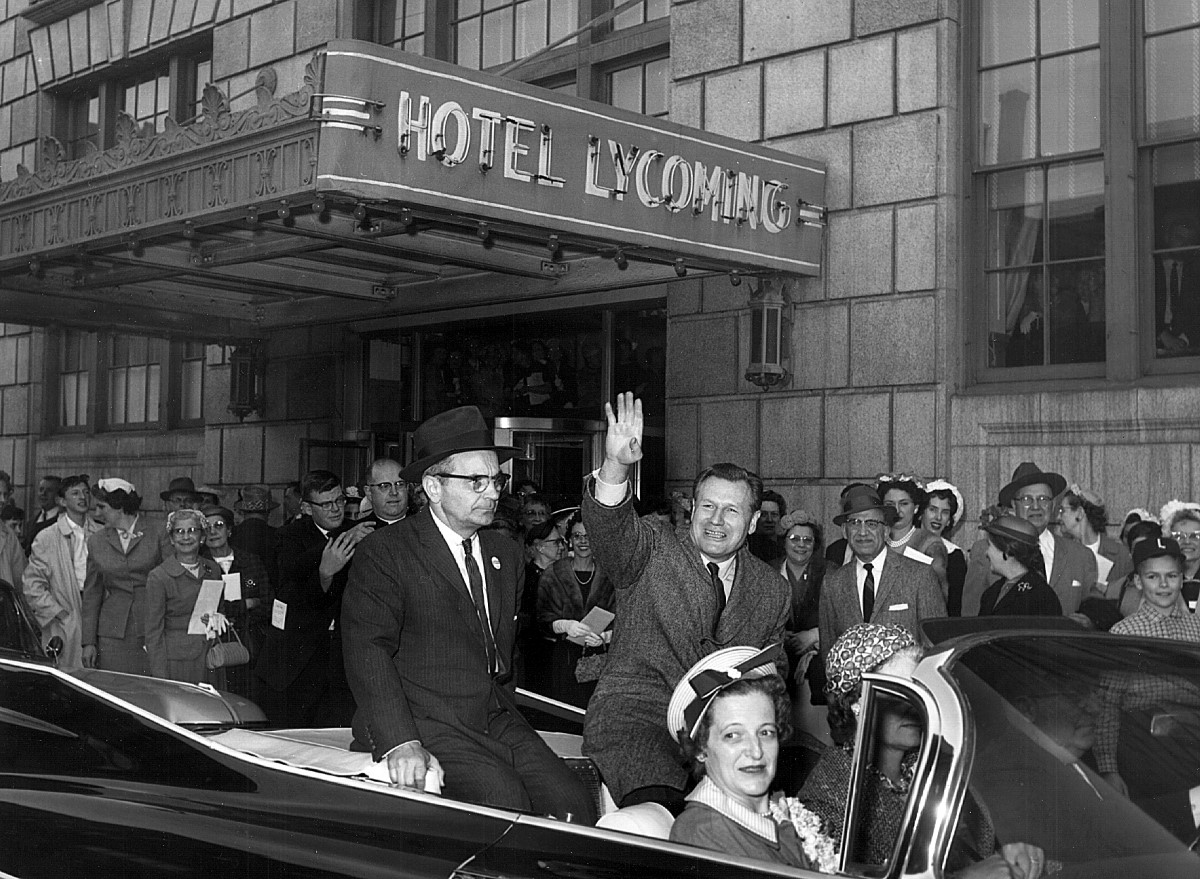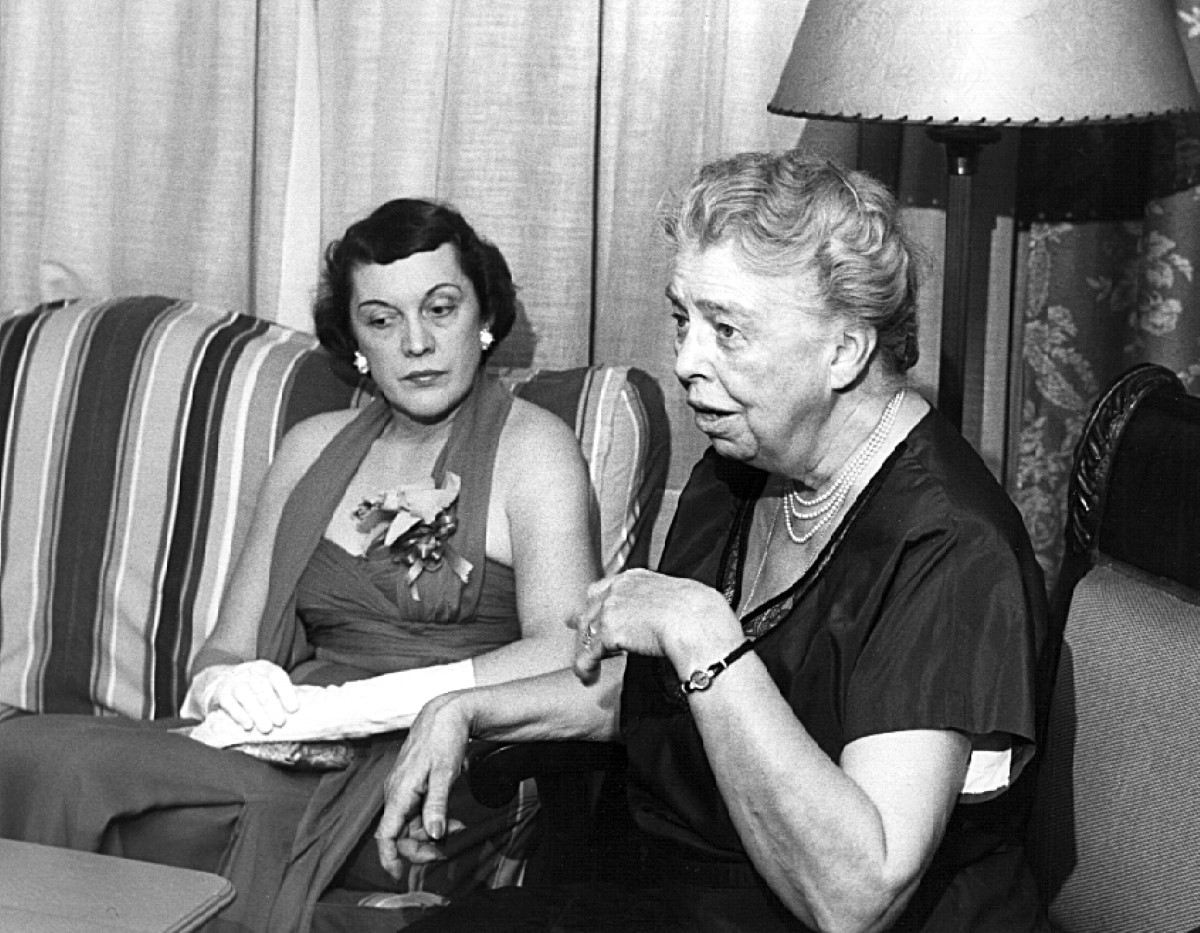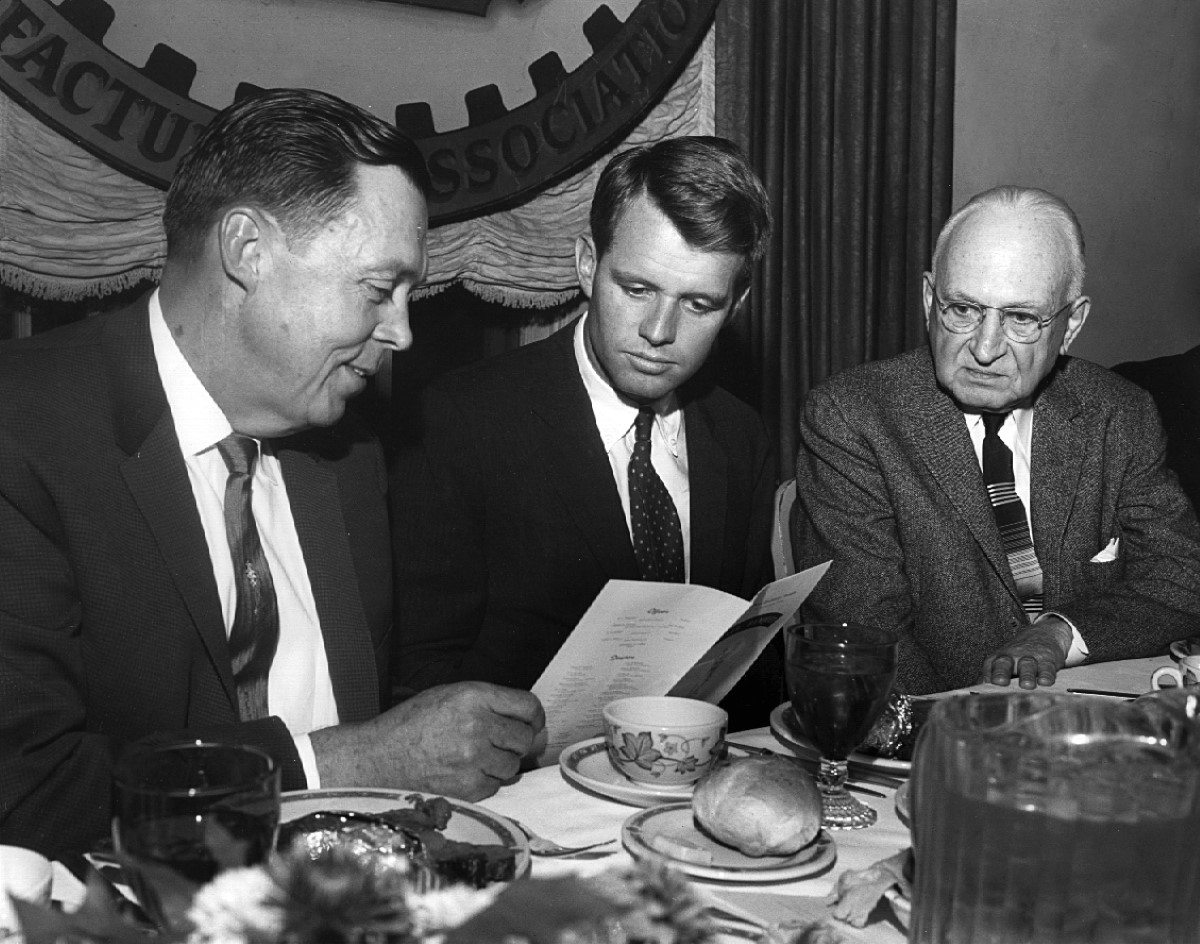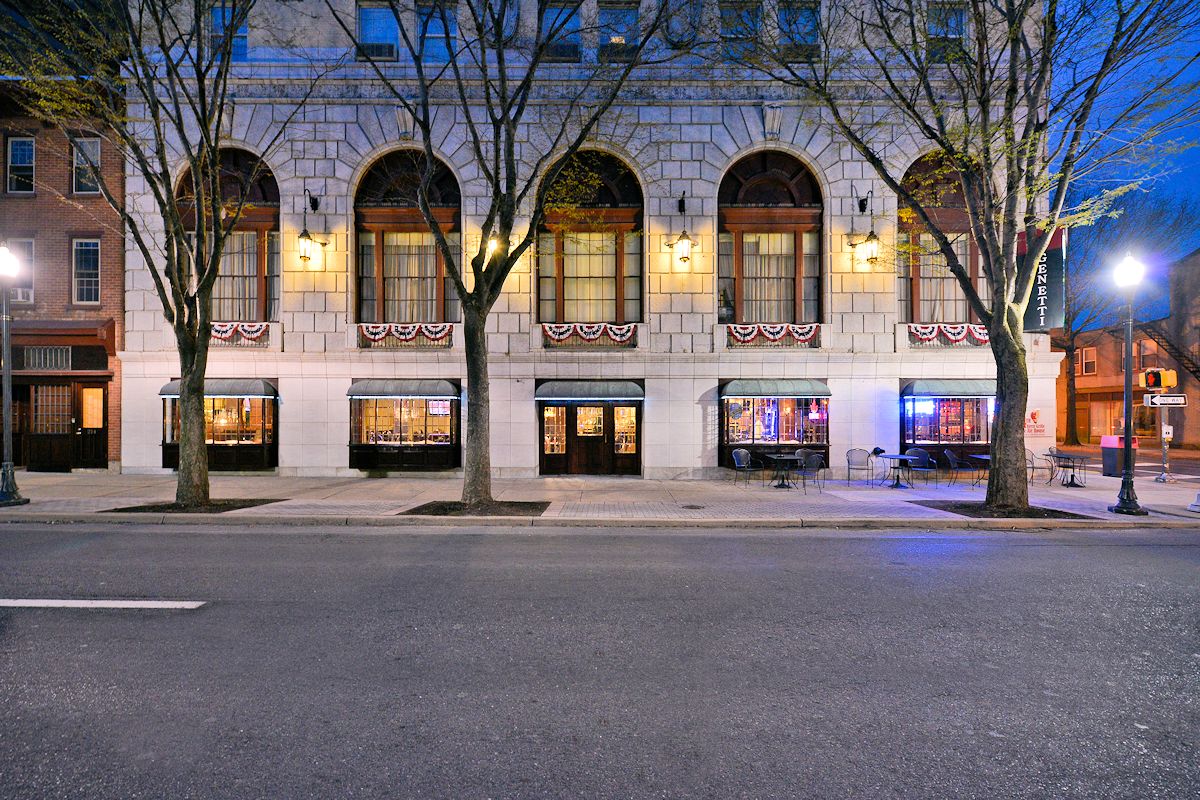Receive for Free - Discover & Explore eNewsletter monthly with advance notice of special offers, packages, and insider savings from 10% - 30% off Best Available Rates at selected hotels.
history
Discover Genetti Hotel & Suites, which has stood as a cherished local landmark in downtown Williamsport for more than a century.
Genetti Hotel & Suites, a member of Historic Hotels of America since 2023, dates back to 1921
VIEW TIMELINEFriendly Persuasion: Genetti Hotel 90th Anniversary Retrospective, circa 2012
Learn about the magnificent history of the Genetti Hotel & Suites.
WATCH NOWBy the beginning of the 20th century, the city of Williamsport was one of the most prosperous communities in all of Pennsylvania. Originally a logging town, the community had since emerged as a multifaceted industrial center, replete with numerous manufacturing operations. Significant wealth flowed into Williamsport, enabling its residents to conduct massive construction projects that greatly transformed the local skyline. Among the groups to commission the creation of a new building was the Williamsport Hotel Company, whose members desired to develop an exquisite hotel in the heart of Williamsport. Sparing no expense, the company ultimately raised around $800,000 to build the structure. They also hired respected experts to craft the hotel’s overall appearance, including prominent architect William Lee Stoddart. In 1921, Stoddart proceeded to oversee the construction of a stunning 10-story edifice that displayed his renowned interpretations of Beaux-Arts-inspired architecture. Gorgeous public spaces appeared throughout the interior floorplan, such as a distinctive ballroom, a spacious lobby, and a gorgeous dining area that possessed breathtaking mosaics. Dozens of guestrooms awaited guests inside as well, with 40 containing their very own bathrooms—a rarity for most other hotels at the time.
When construction finally concluded a year later, the opulent Lycoming Hotel quickly endeared itself to the people of Williamsport. (The home of Williamsport, Lycoming County, acted as the namesake for the hotel.) Many people had become enthralled upon attending the hotel’s grand opening ceremony that summer. The exciting event lasted for three days, starting with Edgar Munson—a board member for the Williamsport Hotel Company—unfurling a large American flag atop the roof before thunderous applause. Hundreds of curious onlookers then filtered into the building, feeling awestruck by its distinctive character and wonderful amenities. Their overwhelmingly positive impressions remained intact for weeks thereafter, which helped turn the Lycoming Hotel into Williamsport’s primary social gathering spot. Soon enough, guests were making frequent arrangements to host their own luncheons, conferences, and balls at the hotel. Several influential community organizations even started using the building for meetings, such as local branches of Kiwanis International, Rotary International, and Lions Club International!
Word spread rapidly of the building’s popularity, which gradually generated wider interest in the Lycoming Hotel throughout the nation. Travelers started to arrive as part of their trips to visit the three prominent colleges around Williamsport, namely Penn College, Cumberland College, and Bucknell University. Others booked a guestroom to attend one of the prominent events hosted in the city, including the famous Little League World Series. (Williamsport became the home of the Little League World Series in 1947, with the Lycoming Hotel serving as the main place where most of the competitors stayed.) Influential figures began to stay on-site regularly, too, including actors, athletes, and intellectuals. Among the most noteworthy names to appear within the hotel’s guestbook were luminaries like Rita Hayworth, Gene Kelly, Aretha Franklin, Connie Mack, Carl Sandburg, and members of the Harlem Globetrotters. Even important politicians visited often, such as former U.S. Attorney General Robert F. Kennedy, Vice President Nelson Rockefeller, and Gerald Ford, the 38th President of the United States!
Then, in 1975, the entrepreneurial Val and Gus Genetti Jr. purchased the historic Lycoming Hotel after reading about it in a regional trade magazine. With a commitment to keep the hotel “a community effort,” the Genettis met with the owners and purchased the business for $600,000. The Genetti family subsequently initiated an expansive restoration that sought to revitalize the building’s rich architectural integrity, that first made it a cherished local landmark decades ago. However, they also began a sweeping series of internal modifications that further enhanced the hotel’s ability to provide a comfortable environment. One of the most lasting changes that the Genetti family instituted was the rebranding of the location, which became known as the “Genetti Hotel & Suites” in 1989. Genetti Hotel & Suites has since maintained its status as a celebrated icon in downtown Williamsport, its heritage and reputation continuing to enchant countless guests. Gus Genetti Jr. still functions as the dedicated owner of this revered historic structure today. He remains steadfastly committed toward ensuring that the hotel is perfectly preserved for many more generations to come. Indeed, the future of this fantastic historic site has never looked brighter.
-
About the Location +
Located along the banks of the Susquehanna River’s West Branch, the city of Williamsport is a truly impressive community with deep history. Its origins specifically harken back to the mid-18th century, when Pennsylvania’s government began assigning large tracts of land in Lycoming County to its inhabitants. (Veterans of the recent French and Indian War were one of the main demographics to receive such a deed.) Among the most prominent recipients was Samuel Wallis, who other pioneers took to calling the “Land King” given the size of his grant. To cultivate the land, Wallis ultimately relocated several families to the area as contracted indentured servants. Perhaps the most successful individuals to work under Wallis was former Philadelphia resident Michael Ross. Ross subsequently served with Wallis for months, gradually developing refined skills as a land surveyor. Those talents seemingly caused the elder Wallis to look upon Ross favorably over time. In fact, Wallis even gave Ross a significant portion of his own estate and a letter of recommendation, which the latter eventually parlayed to secure another couple hundred acres right after the American Revolutionary War. Ross then set about establishing a village in the center of his vast landholding, partnering with a local judge named William Hepburn to create the street grid. Houses soon lined the community’s nascent neighborhoods, as did some storefronts and even a schoolhouse. By 1796, enough of a town had emerged that the two men felt empowered to give it the moniker “Williamsport.” (Although the reasoning behind the name is unclear, oral tradition has since suggested many origins, such as Ross’ own son, William, to Hepburn himself.)
However, Ross and Hepburn yearned to gain the approval to construct a county courthouse on-site, which the Pennsylvania legislature had considered placing in nearby Jaysburg . The two men thus began an intense campaign to change the designation, which eventually led to them offering discounted land for the development of the courthouse in downtown Williamsport. The state commissioners assigned to the project finally relented, resulting in the town earning the title of seat for Lycoming County in 1806. Williamsport grew dramatically over the next several decades, reaching the size of an actual city. Driving this incredible growth was the manifestation of a prosperous logging industry that came to employ thousands throughout much of the 19th century. Indeed, many logging camps had formed in the vast pine and hemlock forests that existed further north of Williamsport. The lumberjacks moved their cut logs by way of the Susquehanna River, floating them downstream to the city in great numbers. But it was often difficult to ensure that the logs arrived at Williamsport, prompting a logger named Major James Perkins to construct the Susquehanna Boom in 1846. (A “boom” is a barrier made of interlocking units—typically other logs—that are meant to collect drifting timber.) The boom greatly enhanced the productivity of the logging industry, making Williamsport one of the nation’s preeminent economic centers for lumber. Dozens of sawmills lined the shoreline in kind, which milled millions in board feet of wood for years. This economic activity, in turn, made some of Williamsport’s residents very wealthy, such as James H. Perkins, Mahlon Fisher, and Peter Herdic. Those individuals built tremendous homes across Williamsport, too, including houses within an extravagant district that locals called “Millionaire’s Row.”
Unfortunately for Williamsport, its lumber industry crashed following a destructive flood in 1889. Most of the sawmill owners had decided against rebuilding their facilities in the wake of the event, which forced most of the logging camps out of business by the beginning of the 20th century. Williamsport managed to endure thanks to the ingenuity of its entrepreneurial citizens, who opened new firms that manufactured goods ranging from machine valves to airplane motors. The city changed in other ways as well, particularly once Carl Stotz began organizing baseball games for neighborhood children during the Great Depression. In 1938, Stotz, his wife, Grace, and their friends in the Bebble family created youth baseball teams that would play against each other during the summer months when schools were closed. In doing so, they hoped to teach the children the values of sportsmanship and teamwork within an enjoyable environment. Much to their delight, the baseball matches proved to be popular, inspiring the group to officially organize them under the country’s first-ever “Little League.” The idea soon spread rapidly throughout the nation, with towns in every state founding their own equivalent. This popularity even inspired Carl Stotz to establish a grand tournament called the “Little League World Series” in 1947, in which America’s best youth baseball teams could compete for a national title. (This contest has since expanded to include Little League teams from around the world.) Williamsport has remained the capital of Little League baseball, with many people coming to watch the annual Little League World Series. In fact, many high-profile broadcast networks even air the contest, such as ABC and ESPN.
-
About the Architecture +
When the renowned architect William Lee Stoddart first began designing the future Genetti Hotel & Suites, he chose Beaux-Arts motifs as his main source of inspiration. In fact, Stoddart himself was respected throughout the country for his interpretations of Beaux-Arts architecture, having already used the form to create a number of fantastic buildings. (Among his most noteworthy examples at the time included The Georgian Terrace and today’s Ellis Hotel Atlanta, A Tribute Portfolio Hotel by Marriott, which are both fellow members of Historic Hotels of America.) Beaux-Arts architecture itself is one of the most commonly seen architectural styles in the United States, despite its European origins. Widely popular around the dawn of the 20th century, this beautiful architectural form originally began at an art school in Paris known as the École des Beaux-Arts during the 1830s. There was much resistance to the Neoclassism of the day among French artists, who yearned for the intellectual freedom to pursue less rigid design aesthetics. Four instructors in particular were responsible for establishing the movement: Joseph-Louis Duc, Félix Duban, Henri Labrouste, and Léon Vaudoyer. The training that these instructors created involved fusing architectural elements from several earlier architectural styles, including Imperial Roman, Italian Renaissance, and Baroque. As such, a typical building created with Beaux-Arts-inspired designs would feature a rusticated first story, followed by more simplistic ones. A flat roof would then top the structure. Symmetry became the defining character, with every building’s layout featuring such elements like balustrades, pilasters, and cartouches. Sculptures and other carvings were commonplace throughout the design, too. Beaux-Arts only found a receptive audience in France and the United States though, as most other Western architects at the time gravitated toward British design principles. Nevertheless, the architectural style came to define the appearance of numerous buildings throughout America, with many surviving well into the 21st century as cherished historical landmarks
-
Famous Historic Guests +
- Gene Autry, actor known for such roles in The Phantom Empire, In Old Santa Fe, and The Old Corral.
- Gene Kelly, actor known for his roles in An American in Paris and Singin’ in the Rain.
- Rita Hayworth, actress known for her roles in Gilda and Cover Girl.
- Paulette Goddard, actress known for her roles in Modern Times, The Great Dictator, and So Proudly We Hail!
- June Havoc, actress known for her roles in Gentlemen’s Agreement, The Iron Curtain, and Hi Diddle Diddle.
- William Gargan, the actor best remembered for his role in They Knew What They Wanted.
- Sergei Rachmaninoff, musician considered by experts to be one of the best pianists of the early 20th century.
- José Iturbi, conductor and pianist who appeared in musicals like Thousands Cheer, Music for Millions, and That Midnight Kiss.
- Aretha Franklin, singer and songwriter hailed as “The Queen of Soul.”
- Cab Calloway, jazz musician and bandleader known for songs like “Long About Midnight,” “The Man from Harlem,” and “Minnie the Moocher.”
- Yehudi Menuhin, musician considered by experts to be one of the best violinists of the 20th century.
- Bob Dylan, Grammy-Award musician known for such singles as “Blowin’ in the Wind,” and “The Times They Are a-Changin’.”
- Carl Sandburg, three-time Pulitzer Prize winner best remembered for his biography on President Abraham Lincoln.
- Pearl S. Buck, writer and novelist best remembered for her Pulitzer Prize-winning book, The Good Earth.
- Ogden Nash, poet celebrated for his historical influence on American light verse poetry.
- Norman Cousins, editor of the Saturday Review, who helped shape public debate about peacefully ending the Cold War.
- Will Durant, historian best remembered for his multivolume work on world history known as The Story of Civilization.
- Jesse Owens, track and field athlete who famously won four gold medals representing the United States at the 1936 Olympic games.
- Wilt Chamberlin, Hall of Fame basketball center, who currently holds 72 records with the National Basketball Association.
- Muhammad Ali, professional boxer and civil rights activist regarded as one of the best athletes of the 20th century.
- Bill Sharman, professional basketball player, coach, and executive who won a total of 15 NBA Championships.
- Ralph Kiner, Hall of Fame outfielder best remembered for his time with the Pittsburgh Pirates.
- Monte Irvin, Hall of Fame outfielder best remembered for this time with the New York (San Francisco) Giants.
- Connie Mack, the longest-serving manager in Major League Baseball history, who currently holds the records for managerial wins, losses, and games managed.
- Clarence Darrow, lawyer known for his involvement in the famous Scopes Trial.
- Theodore Roosevelt III, Secretary of Commerce of Pennsylvania (1949 – 1951).
- Franklin Delano Roosevelt, Jr., former U.S. Congressmen (1949 – 1959) who served as both U.S. Under Secretary of Commerce and Chair of the Equal Employment Opportunity Commission in the 1960s.
- Eleanor Roosevelt, First Lady to former U.S. President Franklin Delano Roosevelt (1933 – 1945)
- Gifford Pinchot, 28th Governor of Pennsylvania (1931 – 1935)
- Barry Goldwater, U.S. Senator from Arizona (1969 – 1987)
- Robert Kennedy, U.S. Attorney General and Senator from New York (1965 – 1968)
- Nelson Rockefeller, 41st Vice President of the United States (1974 – 1977)
- Gerald Ford, 38th President of the United States (1974 – 1977)
-
Women in History +
Eleanor Roosevelt: Genetti Hotel & Suites has hosted countless luminaries throughout its history, ranging from Hollywood celebrities to notable politicians. Among those illustrious individuals was former First Lady Eleanor Roosevelt. She was born Anna Eleanor Roosevelt to Elliott and Anna Hall Roosevelt in 1884. (A member of the Oyster Bay clan of the Roosevelt dynasty, Elliott himself was the brother of former U.S. President Theodore Roosevelt.) Roosevelt’s immediate family cherished community service—a value that was further reinforced when she attended the prestigious Allenswood Boarding Academy in London. She kept those personal influences close to her heart in adulthood, using them as the foundation for her future work as a social activist. Indeed, some of her earliest projects involved tending to the overcrowded tenement houses in New York City’s Lower East Side. Around the same time, she began courting her distant cousin, Franklin Delano Roosevelt. They eventually married in 1905 and had six children together. But the marriage was strained by their dueling personalities, as well as the demands of Franklin’s early political career. Roosevelt often felt her responsibilities as a “political wife” were tedious, especially after her husband’s appointment to the post of Assistant Secretary of War shortly before the outbreak of World War I. Their marriage further deteriorated in 1918, when Eleanor discovered that Franklin had an affair with their mutual friend, Lucy Mercer. Roosevelt thus vowed to throw herself fully back into her political activism.
However, the two had a strong understanding that their fates remained intertwined and aspired to support one another going forward. It was Eleanor who encouraged Franklin to remain in politics when he was beset with polio in 1921. Eleanor Roosevelt was incredibly instrumental in aiding her husband’s election as the Governor of New York in 1928, as well as his subsequent rise to the presidency four years later. She often gave numerous speeches in public on his behalf that galvanized thousands of people. Roosevelt also became a central figure at his campaign events, serving as her husband’s voice whenever he could not attend. But Eleanor Roosevelt still established her own vibrant political career as the First Lady of the United States. Historians today consider her actions to have fundamentally transformed the role that the First Lady traditionally held within the national government. Roosevelt used her position t advance a number of causes close to her heart, including gender equality, civil rights, and housing reform. For instance, she arranged a massive celebration at the nearby Lincoln Memorial to protest the racist decision of the Daughters of the American Revolution to not let Marian Anderson—an African American opera singer—perform at Constitution Hall. On another occasion, she privately lobbied for the passage of the Costigan-Wagner Bill, which would have made lynching a federal crime. Roosevelt even held exclusive press conferences at the White House for female journalists, to help them to break into the field.
Perhaps her greatest efforts involved an attempt to create an experimental community in West Virginia called “Arthurdale,” where homeless miners would have a shot at achieving a new independent life. Even though many considered Arthurdale to be a failure, the town was nonetheless a testimony to her commitment to public service. Eleanor Roosevelt’s historic career continued well after her time at the White House ended upon Franklin’s death in 1945. She played a significant role in turning Hyde Park into a museum dedicated to her late husband’s legacy, which set the precedent for future presidential libraries to follow. She also served as a delegate to the United Nations Commission on Human Rights, rising to become its chairperson. Roosevelt remained with the organization until the early 1950s, and her political insight proved integral toward drafting the Universal Declaration of Human Rights. After working to reform New York politics throughout the remainder of the decade, Roosevelt eventually worked to support the campaign of John F. Kennedy. While she initially rebuffed Kennedy for his refusal to denounce McCarthyism, Roosevelt relented on the grounds that she believed he had the best chance of leading the nation toward a better future. When Kennedy won, she became his representative to such organizations like the National Advisory Committee to the Peace Corps. President Kennedy even appointed her as the First Chair of the Presidential Commission on the Status of Women, although she would pass away mere months after it was organized. Eleanor Roosevelt has since been revered as one of the most influential figures in 20th-century American history and is esteemed across the world today for her years of advocacy.






































